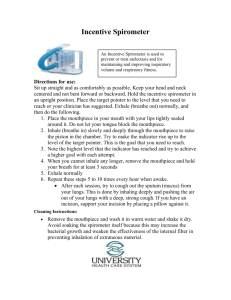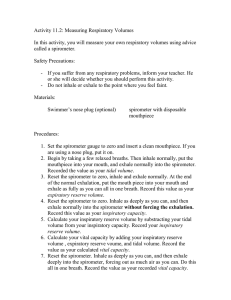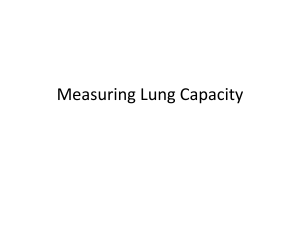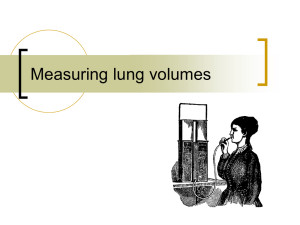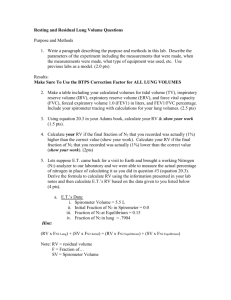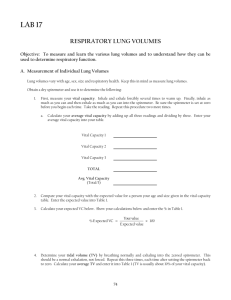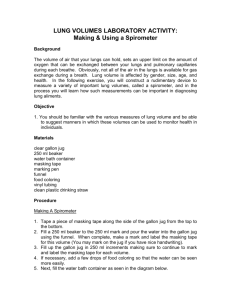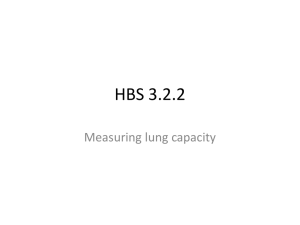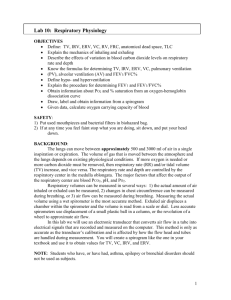Lung Volume Lab: Spirometry & Respiratory Volumes
advertisement
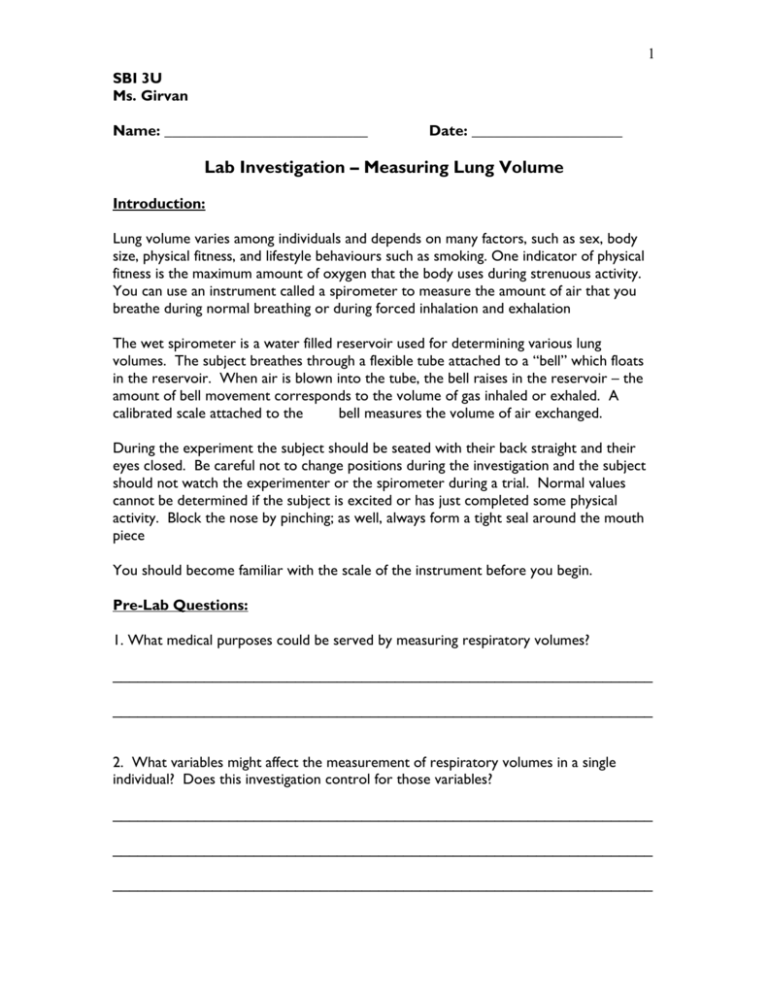
1 SBI 3U Ms. Girvan Name: ___________________________ Date: ____________________ Lab Investigation – Measuring Lung Volume Introduction: Lung volume varies among individuals and depends on many factors, such as sex, body size, physical fitness, and lifestyle behaviours such as smoking. One indicator of physical fitness is the maximum amount of oxygen that the body uses during strenuous activity. You can use an instrument called a spirometer to measure the amount of air that you breathe during normal breathing or during forced inhalation and exhalation The wet spirometer is a water filled reservoir used for determining various lung volumes. The subject breathes through a flexible tube attached to a “bell” which floats in the reservoir. When air is blown into the tube, the bell raises in the reservoir – the amount of bell movement corresponds to the volume of gas inhaled or exhaled. A calibrated scale attached to the bell measures the volume of air exchanged. During the experiment the subject should be seated with their back straight and their eyes closed. Be careful not to change positions during the investigation and the subject should not watch the experimenter or the spirometer during a trial. Normal values cannot be determined if the subject is excited or has just completed some physical activity. Block the nose by pinching; as well, always form a tight seal around the mouth piece You should become familiar with the scale of the instrument before you begin. Pre-Lab Questions: 1. What medical purposes could be served by measuring respiratory volumes? _________________________________________________________________ _________________________________________________________________ 2. What variables might affect the measurement of respiratory volumes in a single individual? Does this investigation control for those variables? _________________________________________________________________ _________________________________________________________________ _________________________________________________________________ 2 Safety Precautions: It is very important for hygienic reasons to use a new mouthpiece for each student. Write your name on it as soon as you have one and hang onto it until you are satisfied that you have successfully completed the investigation. Material and Apparatus: Wet spirometer Disposable Mouth Piece Water **The wet spirometer is designed to measure the volume of air that is forced into it. Do not inhale through the mouthpiece of the spirometer at any time. ** Procedure: Part A – Measuring Tidal Volume (TV) Tidal volume is the amount of air exhaled or inhaled during normal, quiet breathing. 1. The subject should sit by the spirometer, breathing quietly and normally for about one minute before using the spirometer. 2. After inhaling a normal breath the student places the mouthpiece between the lips and exhales in a normal, unforced way into the spirometer. 3. Record the volume in the table. Repeat the procedure three times; making sure that the pointer is reset to zero before each reading. 4. Determine the average Tidal Volume of your three determinations. Part B – Measuring Expiratory Reserve Volume (ERV) Expiratory reserve volume is the amount of air that can be forcibly breathed out after normal expiration. 1. The students sits, breathing normally for a minute or so, then after a normal, unforced exhalation puts the mouthpiece between the lips, and forcible exhales all additional air possible. 3 2. Again, record the results of 3 trials, resetting the spirometer pointer to zero after each. Determine the average of the three trials. Part C – Measuring Inspiratory Reserve Volume (IRV) Inspiratory reserve volume is the amount of air that can be inhaled after a normal, unforced inhalation. 1. Inhale as deeply as you can, and then exhale normally into the spirometer. Do not force the exhalation. Record this value as your inspiratory capacity. 2. To calculate your inspiratory reserve volume, subtract your tidal volume from your inspiratory capacity. Record this value as your inspiratory reserve volume. 3. Again, record the results of 3 trials, resetting the spirometer pointer to zero after each. Determine the average of the three trials. Part D – Measuring Vital Capacity (VC) Vital Capacity is the maximum amount of air that can be forcible exhaled immediately following a maximal inhalation. 1. The student, sitting, slowly and deeply breathes in and out for a while, and then breathes in as deeply as possible, places the spirometer mouthpiece in position, and exhales as forcibly as possible. Repeat three times and record the results in the table. Observations: LUNG VOLUMES TIDAL VOLUME EXPIRATORY RESERVE INSPIRATORY CAPACITY INSPIRATORY RESERVE TRIAL 1 mL TRIAL 2 mL TRIAL 3 mL AVERAGE mL 4 VITAL CAPACITY Calculations: Vital Capacity can also be determined by adding the previously measured lung volumes: VC = IRV + ERV + TV Total Lung Volume The total lung volume is determined by adding the vital capacity and the residual volume. Residual Volume (RV) Residual Volume is the air within the lungs that remains after forcible exhalation. It cannot be measured with the spirometer. For an average, healthy individual make the residual volume is about 1200mL. Complete the following calculations: I. Vital Capacity (VC) = TV + IRV + ERV = = II. Total Lung Volume = VC + Residual Volume = = (note: use measured VC) 5 Discussion: Here are a number of topics to discuss: 1. Define any lung volume terms discussed in the lab. 2. Compare the spirometer results to the calculations and explain any differences. 3. Compare IRV to ERV values and explain why there is a difference between the two. 4. Discuss how lung volumes would differ between each of the following cases: i. athlete vs. non-athlete ii. smoker vs. non-smoker iii. large vs. small person It is necessary to show evidence of outside research in your lab report. Outline of Formal Lab Report: 1. Abstract 2. Introduction 3. Materials/Apparatus 4. Procedure (refer to the lab handout) 5. Observations (lead in sentence, table filled in with reasonable numbers, title below table) 6. Calculations (work and formula shown) 7. Error Analysis 8. Discussion 9. Conclusion 10. References (must be used properly in discussion and listed) **A rubric will be provided to you that outlines the marking scheme. **

